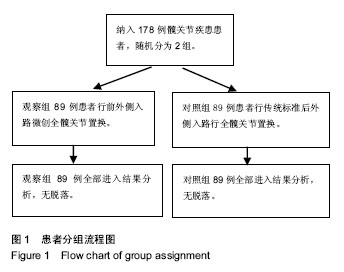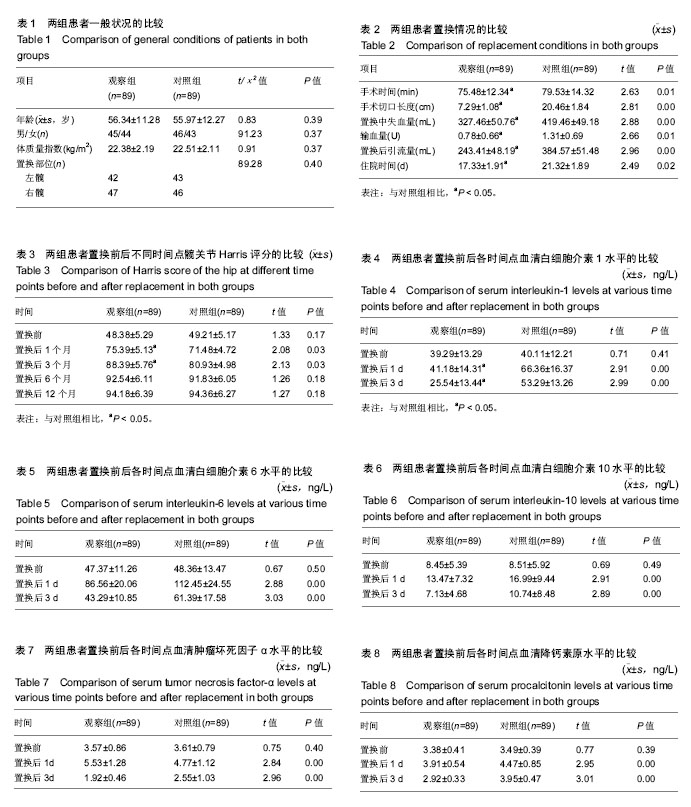| [1] 徐杰,庄伟达,李新炜,等. 直接前入路和后外侧保留梨状肌入路全髋关节置换术的疗效对比[J].北京大学学报(医学版)医学版, 2017, 49(2):214-220.[2] Rolfson O, Bohm E, Franklin P, et al. Patient-reported outcome measures in arthroplasty registries.Acta Orthop. 2016; 87(Suppl 1): 9-23.[3] Gordon M, Rysinska A, Garland A, et al. Increased long-term cardiovascular risk after total hip arthroplasty. Medicine (Baltimore). 2016; 95(6): e2662.[4] Varnum C, Pedersen AB, Mäkelä K, et al. Increased risk of revision of cementless stemmed total hip arthroplasty with metal-on-metal bearings. Acta Orthop. 2015; 86(4): 491-497.[5] 孙启才,茹选良,钱志钢,等.髋关节置换术治疗老年股骨转子间骨折内固定失败的中期随访[J]. 中国骨伤, 2017, 30(7): 591-596.[6] 朱先洋,尹宗生,陈迪嘉.髋关节置换术后翻修原因及疗效分析[J].安徽医药,2017, 21(3):525-528.[7] Yang BH, Li HP, He XJ, et al. Minimally invasive surgical approaches and traditional total hip arthroplasty: a meta-analysis of radiological and complications outcomes. PLoS One. 2012; 7(5): e37947.[8] 艾芳,高辉,何春耒.前侧入路微创髋关节置换术快速康复护理.赣南医学院学报, 2017,37(1):30-31.[9] 高辉,叶山山,何春耒,等.直接前侧入路微创全髋关节置换术中股外侧皮神经损伤的研究进展.中华解剖与临床杂志, 2017,22(3): 248-251.[10] Poitras S, Wood KS, Savard J, et al. Predicting early clinical function after hip or knee arthroplasty. Bone Joint Res. 2015; 4(9):145-151.[11] 周一新.骨科标准新突破手术技术指导规范《人工髋、膝关节置换术》解读[J].中国卫生标准管理,2011,2(04):72-74.[12] 王本杰,赵德伟,谢辉,等.骨水泥型和生物型股骨假体半髋置换修复高龄股骨颈骨折[J].中国组织工程研究, 2015, 19(9): 1345-1351.[13] 李华. Harris评分法与X射线评分法在全髋关节置换术疗效评价的比较[J]. 医学信息旬刊, 2010, 23(5):1334-1335.[14] Berger RA, Jacobs JJ, Meneghini RM, et al. Rapid rehabilitation and recovery with minimally invasive total hip arthroplasty. Clin Orthop Relat Res. 2004; 429:239.[15] Husted H. Fast-track hip and knee arthroplasty: clinical and organizational aspects. Lancet.2013;381(9878):1600-1602.[16] Nakamura S, Matsuda K, Arai N, et al. Mini-incision posterior approach for total hip arthroplasty. Int Orthop. 2004; 28(4): 214-217.[17] Smith TO, Blake V, Hing CB. Minimally invasive versus conventional exposure for total hip arthroplasty: a systematic review and meta-analysis of clinical and radiological outcomes. Int Orthop. 2011;35(2):173-184.[18] Mclaughlin JR, Lee KR. Total hip arthroplasty with an uncemented tapered femoral component in patients younger than 50 years of age: a minimum 20-year follow-up study. J Bone Joint Surg Br. 2016; 31(6):1275-1278.[19] Hallab NJ, Cunningham BW, Jacobs JJ. Spinal implant debris-induced osteolysis. Spine. 2003; 28(20):S125-138.[20] Singh P, Castillo A, Majid DSA. Decrease in IL-10 and increase in TNF-α levels in renal tissues during systemic inhibition of nitric oxide in anesthetized mice. Physiol Rep.2014;2(2): e00228.[21] Grassmé H, Gulbins E. CD95/CD95 ligand interactions on epithelial cells in host defense to Pseudomonas aeruginosa. Science. 2000;290(5491):527-530.[22] Knoferl MW, Angele MK, Catania RA, et al. Immunomodulatory effects of dehydroepiandrosterone in proestrus female mice after trauma-hemorrhage. J Appl Physiol.2003,;95(2):529-535.[23] Wakefield TW, Henke PK. The role of inflammation in early and late venous thrombosis: Are there clinical implications. Semin Vasc Surg. 2005; 18(3):118-129.[24] Mocellin S, Marincola FM, Young HA. Interleukin-10 and the immune response against cancer: a counterpoint. J Leukoc Biol. 2005; 78(5):1043-1051.[25] Yuan K, Li WD, Qiang Y, et al. Comparison of procalcitonin and C-reactive protein for the diagnosis of periprosthetic joint infection before revision total hip arthroplasty. Surg Infect (Larchmt).2015;16(2):146-150.[26] Wunder C, Eichelbrönner O, Roewer N. Are IL-6, IL-10 and PCT plasma concentrations reliable for outcome prediction in severe sepsis? A comparison with APACHE III and SAPS II. Inflamm Res. 2004;53(4):158-163.[27] Chang YL, Chen TH, Wu YH, et al. A novel TLR2-triggered signalling crosstalk synergistically intensifies TNF-mediated IL-6 induction. J Cell Mol Med. 2014;18(7):1344-57.[28] Thomas H, Marcel K, Zorn CN, et al. Activation of the PI3K pathway increases TLR-induced TNF-α and IL-6 but reduces IL-1β production in mast cells. Cell Signal. 2011; 23(5): 866-875.[29] Haimovich B, Reddell MT, Calvano J E, et al. A novel model of common Toll-like receptor 4- and injury-induced transcriptional themes in human leukocytes. Crit Care. 2010; 14(5):177-186.[30] Das MA, Panda SK, Pradhan AK, et al. Filarial antigens mediate apoptosis of human monocytes through Toll-like receptor 4. J Infect Dis. 2014; 210(7):1133-1144.[31] Babu S, Bhat SQ, Kumar NP, et al. Attenuation of toll-like receptor expression and function in latent tuberculosis by coexistent filarial infection with restoration following antifilarial chemotherapy. PLoS Negl Trop Dis. 2009; 3(7):e489-497.[32] Larsen JM, Benn C S, Fillie Y, et al. BCG stimulated dendritic cells induce an interleukin-10 producing T-cell population with no T helper 1 or T helper 2 bias in vitro. Immunology. 2007; 121(2):276–282. |
.jpg)


.jpg)